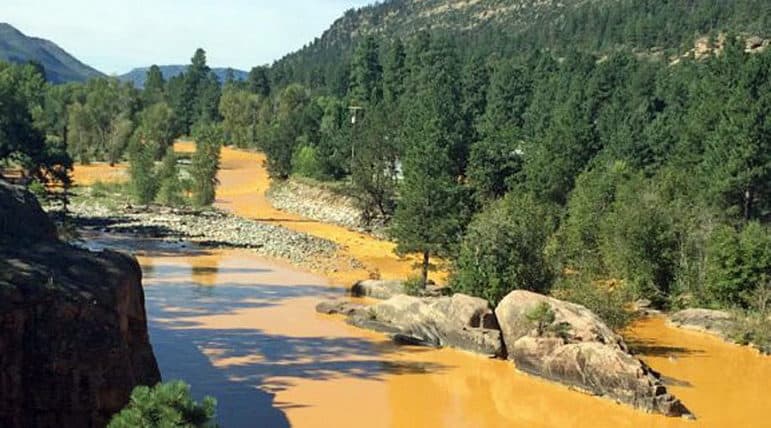
La Plata County / Courtesy photo
A scene from the Animas River in La Plata County, Colo., after the Gold King Mine spill in August. While the EPA has claimed the water is safe and back to “pre-spill” conditions, New Mexico’s monitoring has shown otherwise, the state’s environment secretary told lawmakers Wednesday. A graphic created for the presentation revealed spikes in metal levels, significantly higher than those allowed by the EPA, following storm events over the last few months.
State Environment Secretary Ryan Flynn railed against the Environmental Protection Agency during a House committee meeting Wednesday, saying the federal agency has attempted to “deflect, downplay and minimize” the extent of damages to public health and the environment following the Gold King Mine spill in August.
“This is still a major problem for the state of New Mexico and the communities that rely on this water,” Flynn told members of the House Agriculture, Water and Wildlife Committee. The spill, which occurred in the Animas River near Silverton, Colo., flowed into New Mexico waterways.
Flynn said the EPA has lagged behind New Mexico’s own initiative for cleanup, and he criticized the agency’s proposal that calls for monitoring water quality for just one year.
The EPA did not respond to requests for comment Wednesday.
Flynn outlined state efforts that include long-term monitoring of the groundwater, reimbursement of $1.6 million in emergency response costs associated with the spill and remediation of abandoned mines upstream of the Animas River. Initial costs for the next two years are estimated to be $5 million.
“They are not taking anywhere near partial responsibility,” Flynn said. “I haven’t seen anyone lose their job or any accountability at EPA for what has occurred.”
The department announced last month its intent to sue the EPA, the state of Colorado and two mining corporations related to the spill, stating that their efforts to monitor and clean up the aftermath of the spill or to “protect the people of New Mexico” were “woefully inadequate,” according to the notice.
The department said it will seek “complete remediation” by the parties listed, as well as close to $1 million from the state budget to begin litigation against the listed parties.
This budget allocation is still pending.
“If we want to address these issues, we need resources to do it,” Flynn said.
While the EPA has claimed the water is safe and back to “pre-spill” conditions, state monitoring has shown otherwise, he said.
A graphic created for the presentation revealed spikes in metal levels, significantly higher than those allowed by the EPA, following storm events over the last few months.
Lead, arsenic and mercury were some of the metals found to be highly potent, and Flynn said this indicated the safety of produce and livestock reliant on this water, and sold for consumption, is unverifiable.
Flynn also said the EPA had prior knowledge the spill could occur but did not take action.
“The EPA is not holding themselves to the same high standards for investigation or remediation imposed on the regulated community,” he said.
He says the state is far from recovering from the damages that began Aug. 5, when EPA contractors attempting to drain wastewater from the abandoned mine instead caused 3 million gallons of water, containing 880,000 pounds of toxic metals, to flow into the Animas River, contaminating crops, drinking water and soil in significant portions of Northern New Mexico.
Rep. Roberto “Bobby” Gonzales, D-Taos, suggested a think tank be formed to address the wide swath of issues the committee has seen related to remediation during this session, including a deficit in forest restoration and an abandoned brine well in Carlsbad that is at risk of imminent collapse.
Rep. George Dodge Jr., D-Santa Rosa, asked if there was a way to hold the responsible mining companies accountable for the damages.
Flynn said many of these abandoned mines — there are at least 15,000 in the state — were created before state or federal regulations existed. He said financial assurances for cleanup are required by current mining permits, but “there is room for improvement.”
On Jan. 29, the U.S. Court of the Appeals required the EPA to finalize regulations that would create financial responsibility for hard-rock mining companies.
EPA spokeswoman Laura Allen said in an email following that decision that the focus on hard-rock mining was based on the “extent of environmental contamination,” a potential of companies to file for bankruptcy and skirt costs, as well as “the annual quantities of hazardous substances released to the environment.”
Allen said the agency plans to complete new rules by Dec. 1, as required by the court order.
Rebecca Moss can be reached at rmoss@sfnewmexican.com or (505) 986-3011.